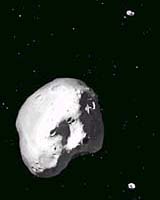Please note, this article is over two years old.
Images of asteroid 3 Juno taken with the 100-inch Hooker telescope at Mt. Wilson Observatory show what appears to be a 60-mile-wide crater. The crater is visible as a darkened area in the lower left quadrant in the 833 nm and 934 nm images. The material excavated by the collision that produced the crater "bite" has low reflectance, especially at the wavelength of 934 nm. An adaptive optics system provided a remarkably clear view of Juno's surface by reducing interference from the Earth's atmosphere. (Sallie Baliunas et al.)

1 posted on
06/02/2006 11:16:53 PM PDT by
SunkenCiv
To: SunkenCiv
Um... "put some ice on that"?
2 posted on
06/02/2006 11:19:35 PM PDT by
thoughtomator
(A thread without a comment on immigration is not complete)
To: 75thOVI; AndrewC; Avoiding_Sulla; BenLurkin; Berosus; CGVet58; chilepepper; ckilmer; demlosers; ...
Please note: this article is over two years old.
The impact may very well have occurred between 1804 and 1839.
3 Juno
HohmannTransfer.com
3 Juno was discovered on 1 Sept. 1804 in Germany by Karl L. Harding, and is estimated at 240 km. in diameter. According to James L. Hilton [1999], Juno's orbit was observed to change in 1839, "very likely" due to an "unmodeled encounter." IAUCs 3431 and 3444/51 report on a stellar occultation by Juno on 11 Dec. 1979.
3 posted on
06/02/2006 11:19:44 PM PDT by
SunkenCiv
(https://secure.freerepublic.com/donate/)
5 posted on
06/02/2006 11:21:16 PM PDT by
SunkenCiv
(https://secure.freerepublic.com/donate/)
6 posted on
06/02/2006 11:21:42 PM PDT by
SunkenCiv
(https://secure.freerepublic.com/donate/)
Hubble finds possible crater of fresh ice on space rock
Spaceflight Now
September 14, 2000
8405 Asbolus, a 48-mile-wide (80-kilometer) chunk of ice and dust that lies between Saturn and Uranus, looks like it has a fresh crater less than 10 million years old, exposing underlying ice that is apparently unlike any yet seen. Donald W. McCarthy of the University of Arizona (UA) in Tucson speculated that "the event that caused the impact crater on 8405 Asbolus also knocked it out of the Kuiper belt." By latest count, scientists have discovered a total of 21 Centaurs, which are dim, small bodies, which are icy like comet nuclei. These objects are considered escapees from a vast reservoir of comets, the Kuiper Belt beyond Pluto. The Centaurs' orbits were perturbed into the region between the orbits of Neptune and Jupiter.

7 posted on
06/02/2006 11:50:18 PM PDT by
SunkenCiv
(https://secure.freerepublic.com/donate/)
Meteors Cause Visible Lunar Explosions
by Stefano Coledan
Popular Mechanics, 2002
Leonid meteor showers are produced when particles from the tail of the comet Tempel-Tuttle encounter the Earth's atmosphere at a speed of more than 60,000 mph... Unlike Earth, however, the moon doesn't have a protective atmosphere... when kilogram-size Leonids hit the lunar surface, they explode in spectacular fashion, digging craters and melting the terrain with temperatures reaching up to 200,000° F... only since 1999 that explosions on the moon have been seen from Earth, Cooke says. In fact, at least six Leonids hit the moon in 1999, causing explosions visible from Earth.
8 posted on
06/02/2006 11:53:10 PM PDT by
SunkenCiv
(https://secure.freerepublic.com/donate/)
12 posted on
06/03/2006 7:22:51 PM PDT by
SunkenCiv
(https://secure.freerepublic.com/donate/)
FreeRepublic.com is powered by software copyright 2000-2008 John Robinson


